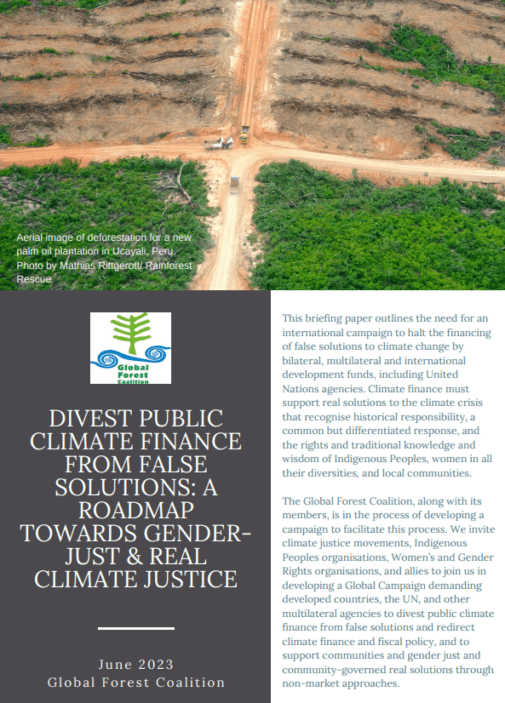Forests, Indigenous Peoples and Sustainable Development – No Connection according to UN logic
By Simone Lovera and Mrinalina Rai
One would think that if two conferences take place in the very same building at the very same time, there would be some connection between the discussions and outcomes. Alas, in the big bureaucratic jungle of the UN Headquarters in New York this is usually not the case. In April, for example, a colorful meeting of the UN Permanent Forum on Indigenous Issues (UNPFII) with hundreds of Indigenous representatives was held literally down the corridor from a meeting to elaborate the post-2015 development agenda. The UNPFII recommended amongst others that the action points on data disaggregation, land rights, traditional knowledge, the implementation of free, prior and informed consent, access to justice and traditional knowledge[1] agreed upon in the outcome document of the World Conference on Indigenous Peoples should be integrated in the post-2015 development agenda. It further recommended that Indigenous Peoples be engaged in the Expert Group in developing key indicators to monitor implementation of the proposed agenda. But sadly these recommendations[2] were almost squarely ignored in the post-2015 process. Despite its central message “Leave No One Behind”, Indigenous Peoples remain almost invisible in the goals and targets. Only one of the proposed indicators[3] recognizes the roles that Indigenous Peoples and local communities and their conservation initiatives can play in the implementation of the Sustainable Development Goals (SDGs), and this indicator is under threat as being considered ‘unfeasible’.
Similarly, while these meetings were literally back-to-back to a meeting of the UN Forum on Forests, the Forum (UNFF) paid virtually no attention to the latest stage of negotiations on the post-2015 agenda, or to the recommendations of the UN Permanent Forum on Indigenous Issues. The UNFF did recommend at the end of the session that it wanted “forests” to be taken into account in the post-2015 agenda, though. Obviously, interagency coordination is a one-way street for the foresters that still dominate the UNFF; the rest of the world should listen to the UNFF, according to the UNFF, but the UNFF can totally ignore what is happening in other forest-related processes.
Killing off a Nasty F(fD)ly?
The only meetings that were perhaps too well interlinked were the April session of the negotiation process on the post-2015 development agenda and the first negotiation session on the outcomes of the Financing for Development Summit (FfD), which will be held in July 2015 in Addis Ababa. In an obvious attempt to kill off an independent follow-up track to the FfD, which is seen as a nasty little fly in the UN system by most donor countries and “their” international financial institutions, developed countries proposed to merge these two processes and use the outcomes of the FfD as the Means of Implementation for the post-2015 development agenda. However, developing countries and NGOs have pointed out both processes are complementary. While the latest draft of the FfD outcomes happily agrees on the establishment of a Technology Facilitation Mechanism, for example, the proposal for this mechanism still fails to recognize the contribution of traditional knowledge and other forms of community technology to sustainable development.
To highlight this contribution, the Global Forest Coalition (GFC) in collaboration with the Women’s Major Group, ETCgroup, UNCTAD, UN NGLS and Tebtebba organized a side event “Non-Financial Means of Implementation”[4] on 24 April. The event addressed a broad range of non-financial means of implementation of the SDGs, including the need for technology and a technology facilitation mechanism to recognize traditional knowledge in community conservation and other forms of collective action.
Nonsensical Forums continuing with Business as Usual
To make things worse, the four meetings that took place were all astonishingly nonsensical. Both the PFII and the UNFF wasted many hours reviewing their own institutional structure in recognition of the fact that a “forum” has not exactly proven to be an action-oriented institutional set-up in UN circles, but both forums failed to agree on any significant improvements in this respect.
The negotiations on the post-2015 Development Agenda, which took place from 21 to 24 April and from 18 to 22 May are supposed to be the most significant negotiation process of this decade, as the SDGs that might form the heart of this agenda will determine priorities for development support and, hopefully, national economic development, for the coming 15 years. That there is formal agreement such development should now be sustainable has been one of the most important breakthroughs in UN policy making of the past 5 years. And while far from perfect, the 17 SDGs and 169 targets that were provisionally adopted in July 2014 could potentially form a framework for the transformative change that is needed – a term that is happily no longer shied away from UN circles. The only painful thing is that it was already agreed there would be additional negotiation sessions despite the fact that the heart of the post-2015 agenda was already agreed upon, and some countries, and industries, seem adamant on using this extra negotiation time to water down what was agreed.
Aligning Forest Targets with Industry Goals?
During the May Post 2015 negotiations, that were to focus on follow-up and review of the post-2015 development agenda, the co-facilitators provided a revised target document for consideration in which the targets had undergone ‘technical proofing’ to keep them ‘consistent’ with international agreements[5]. Sadly, the target that is most under threat is the target to halt deforestation by 2020 (target 15.2). An industry-led New York Declaration on forests that was adopted in September 2014 mentions the target to halt deforestation by 2030 and various actors are now trying to “align” the UN target with this far weaker industry target, which would be responsible for the additional loss of at least 170 million hectares of forests. Sadly, the UNFF did not sound a peep of protest against this massive forest loss proposed, showing once again that the forestry sector is more interested in forest funds than in forest protection.
*Simone Lovera is Executive Director and Mrinalina Rai is Indigenous Peoples Advisor of the Global Forest Coalition
[1]See also the Study on the treatment of traditional knowledge in the framework of the United Nations Declaration on the Rights of Indigenous Peoples and the post-2015 development agendahttp://www.un.org/Docs/journal/asp/ws.asp?m=E/C.19/2015/4
[2] Link to the Report of the Fourteenth Session of the UNPFII http://dacess-dds-ny.un.org/doc/UNDOC/GEN/N15/143/74/PDF/N1514374.pdf?OpenElement
[3] Proposed indicator 15.C.2, which is qualified as ‘non-feasible’ by the UN Statistical Committee in its interim report WEBLINK
[4] Side event presentation at April IGN by GFC at https://globalforestcoalition.org/resources/forests-and-climate-change/
[5]Discussion paper on Follow-up and Review of the Post-2015 Development Agenda (May).https://sustainabledevelopment.un.org/content/documents/7109maypost2015agenda.pdf







